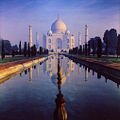Myths
Ever since its construction, the
building has been the source of an admiration transcending
culture and geography, and so personal and emotional responses
to the building have consistently eclipsed scholastic appraisals
of the monument.
A longstanding myth holds that Shah
Jahan planned a
mausoleum to be built in black
marble across the Yamuna river.
The idea originates from fanciful writings of
Jean-Baptiste Tavernier, a
European traveller who visited Agra in 1665. It was suggested
that Shah Jahan was overthrown by his son Aurangzeb before it
could be built. Ruins of blackened marble across the river in
Moonlight Garden, Mahtab Bagh, seemed to support this legend.
However, excavations carried out in the 1990s found that they
were discolored white stones that had turned black. A more
credible theory for the origins of the black mausoleum was
demonstrated in 2006 by archeologists who resconstructed part of
the pool in the Moonlight Garden. A dark reflection of the white
mausoleum could clearly be seen, befitting Shah Jahan's
obsession with symmetry and the positioning of the pool itself.
No evidence exists for claims that
describe, often in horrific detail, the deaths, dismemberments
and mutilations which Shah Jahan supposedly inflicted on various
architects and craftsmen associated with the tomb. Some stories
claim that those involved in construction signed contracts
committing themselves to have no part in any similar design.
Similar claims are made for many famous buildings. No evidence
exists for claims that
Lord William Bentinck, governor
of India in the 1830s, supposedly planned to demolish the Taj
Mahal and auction off the marble. Bentinck's biographer John
Rosselli says that the story arose from Bentinck's fund-raising
sale of discarded marble from Agra Fort.
In 2000, India's Supreme Court
dismissed
P.N. Oak's petition to declare
that a Hindu king built the Taj Mahal.
Oak claimed that origins of the Taj, together with other
historic structures in the country currently ascribed to Muslim
sultans pre-date Muslim occupation of India and thus, have a
Hindu origin. A more poetic
story relates that once a year, during the rainy season, a
single drop of water falls on the cenotaph, as inspired by
Rabindranath Tagore's
description of the tomb as "one tear-drop...upon the cheek of
time". Another myth suggests that beating the silhouette of the
finial will cause water to come forth. To this day, officials
find broken
bangles surrounding the
silhouette.



